Forgotten History: The Chicago White People’s Uprising of 1966 – Part One
by Martin Kerr
THE BASIC MEANING of the word “history,” as most people understand, it is “the record of past events.” That is close to the truth, but a more exact definition would be, “the record of past events that are remembered.” The truth is that human memory, whether individual or collective, is imperfect. Sometimes the memories of even important events are forgotten — or are deliberately suppressed. In such cases, as time passes, it is as though these forgotten events never took place.
And so it is with the Chicago White People’s Uprising of the summer of 1966. Although it was front page, headline news across the world when it occurred, today it has faded from the public mind. Even within the White Nationalist movement, such as it is, the uprising is almost unknown, except in the fading memories of those who lived through it, the youngest of whom are now in late middle age.
If you attempt to research the matter online — good luck! Unless you dig up the front pages of the Chicago Tribune and other newspapers, you will find next to nothing. At most, the only scattered references that remain are to what are euphemistically called the “Open Housing Riots of 1966.” And the role of George Lincoln Rockwell and his National Socialist followers in focusing and leading the revolt has likewise disappeared from the public record. In truth, the uprising so unnerved the powers that be, that they have cleansed it from the historical record, lest it serve as precedent and example for other angry Whites.
Background
Chicago was a segregated city back in the 1960s. There were Black areas and White areas. Working class Whites, many of whom were of Eastern or Southern European ethnic descent, lived in tightly-knit communities. Their small houses were kept in good repair, and their lawns and gardens were tidy and well-maintained. The streets were clean, and there was little crime. In contrast, the Negro sections were rundown and blighted. There was garbage in the streets and many derelict buildings. These were dangerous neighborhoods in which to live — especially after dark.
A logical remedy for the contrasting communities was for the Negroes to fix up their own neighborhoods. Clean up the trash, plant grass on the lawns, turn in the criminals to the police. But instead, the Black masses were informed that their difficulties were not their own fault, but rather were caused by “White racism.” They were further told that the solution to their plight was that Negroes should be allowed to live in the nice, clean White areas of town. This idea was a non-starter with the Whites, for they knew with mathematical certainty that if they allowed Negroes to move into their all-White communities, their pleasant lower-middle-class streets would quickly become dirty and crime-ridden. The value of their houses would drop by 70 percent. Their sons would be assaulted and their daughters would be raped.
And so, the good White people of Chicago resisted any and all efforts to integrate their neighborhoods with Negroes.
Beginning in January, 1966, local Negro leaders began a concerted campaign to break up the all-White neighborhoods by insisting that Negroes be allowed to buy any houses that were put on the market. But the White ethnics refused to sell to Blacks. Thereupon Black “community leaders,” such as Al Raby and a young Jesse Jackson, began to pressure the city fathers and real estate agencies to force the sale of White houses to Blacks. The authorities initially rebuffed the Black demands. So the Black leadership upped the ante by staging a series of noisy, provocative marches through the quiet White neighborhoods. This move got everybody’s attention — including that of professional “civil rights” troublemaker Martin Luther King, Jr. King had just finished a round of agitating and demonstrating in the Deep South, and was looking for new venues to exploit. His income was dependent on the headlines that he could generate, and the explosive situation in Chicago seemed perfect for his purposes.
King and his entourage arrived in Chicago in July. The scene was set for a showdown between the Black agitators, organized under the umbrella of the Chicago Freedom Movement, and the White homeowners.
First Clashes
On Saturday, July 30, a Negro march was held through the White enclave of Marquette Park. It was led by Raby and Jackson. Unlike past marches, this time the Blacks were met with unified and ferocious physical resistance from the White community. The marchers found the local Whites, most of whom were of Eastern European ancestry, in a combative mood: they had no intention of turning their community over to the Blacks.
Hostile Rockwell biographer William Schmalz describes what happened next:
[The marchers] were pelted with a barrage of rocks, bottles, and bricks by white onlookers, a few of whom were arrested. The next day an indignant Al Raby again led marchers through Marquette Park. Swarms of white men ran into the park and overturned every car driven by the marchers. Ice picks and single-edged razors punctured and slashed tires, and youths with lighter fluid set them on fire. Any car bearing the bumper sticker “Union to End Slums” was singled out and totally destroyed. The evening sky was illuminated by burning automobiles.
The violent White uprising had begun.
The Blacks refused to back down, and demanded increased police protection. On August 5, King himself led a march. Again the Negroes were showered with rocks and debris by the enraged Whites. One rock hit King on the head and knocked him down. He told reporters, “I have seen many demonstrations in the South, but I have never seen any so hostile and so hateful as I have seen here today.”
A thousand miles away in Arlington, Virginia, the situation in Chicago was being closely monitored by George Lincoln Rockwell at the headquarters of the American Nazi Party. He and his staff watched news coverage of the violence on television and read about it in the newspapers. Rockwell was also receiving first-hand reports on the White riots from the leader of his Chicago unit, Lt. Chris Vidnjevich. The ANP had a small storefront headquarters on Ohio St., near the center of the clashes. Rockwell told Vidnjevich to offer the embattled Whites whatever aid and leadership he could.
Rockwell realized that this was a perfect opportunity to move the ANP away from the political fringes and into the mainstream of White society. He sent out an emergency fund-raising letter to the ANP mailing list: without financial resources, the ability to the ANP to capitalize on the situation would be very limited. His backers came through for him. Masses of literature addressed to the White people of Chicago were printed up, and cadre members from Arlington were dispatched to Marquette Park to boost Vidnjevich’s tiny numbers. Among the printed material was something new: cardboard posters with a large Swastika and the words “WHITE POWER.”
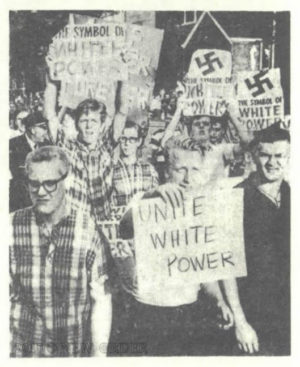
The Negroes continued their marches, and each time they were met with renewed White resistance. A party member from Arlington arrived in Chicago on the morning of Aug. 14, bringing with him several thousand of the newly-designed placards. Another “open housing” march was scheduled for the Italian neighborhood around Gage Park for that afternoon. Vidnjevich and the other ANP members hurriedly distributed the White Power signs to young adults and teens waiting to confront the Blacks. When the Negro marchers arrived at Gage Park they were met with thousands of angry local residents chanting “White Power” and waving a sea of Swastika signs. Soon the chanting gave way to more aggressive behavior from the White workers, and volley after volley of rocks and bottles hit the “civil rights” procession. Dozens of Whites were arrested, but the march was turned back.
Some 2,000 Whites, still fired up from the battle, milled around the park. An ANP officer mounted a bench, and exhorted the crowd to increased resistance. “Buy yourselves guns and teach your wives to use them, too,” he shouted. When he was done, a group of 300 Whites broke from the park and ran to a nearby thoroughfare, where they unleashed a barrage of rocks and bottles on every passing vehicle that contained Negroes. Schmalz reports,
When police tried to make arrests the mob turned on them until warning shots were fired. Two policemen were injured and thirteen people were arrested. One policeman said that it was the closest thing to war that he had ever seen.
The White uprising was in full swing.
Enter George Lincoln Rockwell
Rockwell was heartened as he watched these events unfold on a small black-and-white television set in his office. For years he had been predicting that the day would come when White people were pushed too far and would turn to National Socialism for leadership. And now that day seemed to be at hand. He realized that the type of White violence that was taking place in Chicago had its limits. If it reached the point where it could no longer be contained by the police, the governor would call out the Illinois National Guard and impose martial law. The uprising would be crushed, and the Negroes would get their way at the points of bayonets. What was needed at this juncture was organization and focus for White anger, some way to transform rock-throwing into solid political muscle. Rockwell felt that he and the ANP could provide brains for the brawn that the Chicago workers and homeowners had displayed.
On Sunday, August 21, Rockwell arrived in the Windy City in his huge camper and parked it in Marquette Park, which had become the center of White resistance. He gathered his small band of followers around him. The camper itself was decked out in a gigantic Swastika and a sign reading “Symbol of WHITE POWER.”
Here is Schmalz’s account of the rally, which was the first National Socialist gathering of its type since the end of the Second World War:
As the day wore on, more than 2,000 people congregated around [the camper]…Chris Vidnjevich stepped to the microphone and gave a brief talk. He was showered with applause. Finally, Patler returned to the microphone to introduce Rockwell.
The crowd roared with an exuberance that Rockwell had never experienced before. Unlike college audiences applauding out of respect, these people needed him…
A man in the crowd attempted to heckle Rockwell but was shouted down by other bystanders. Rockwell told the crowd that he would personally lead a White Power march through the “blackest and rottenest section of Chicago.” He concluded his speech by asking the crowd to shout “White Power” loud enough for “Martin Luther Coon” to hear it across town. Over and over again, when Rockwell yelled “WHITE!” the crowd responded with “POWER!”
Rockwell climbed down from the camper to walk among the crowd and shake hands while Patler and Vidnjevich moved through the audience with baskets collecting donations. When they returned to the camper their baskets were filled with more than $1,500. After eight long, heart-breaking years of hardship, desertion and physical attacks, here at last was a legion of white Americans accepting him as a leader. He was moved to tears.
The White people of Marquette Park were enthusiastic about Rockwell and the ANP. Everyone else had abandoned them in their struggle to preserve their neighborhoods: the politicians, the police, the churches, the news media — all were against them. One homeowner told the Chicago Tribune, “If the Nazis are building an organization as a buffer against the niggers, thousands will join it.” Rockwell announced that the ANP would organize a local self-defense formation called the “White Guard.” A spirit of revolutionary ferment permeated the besieged working class Whites, and the National Socialists were determined to exploit it to the maximum degree.
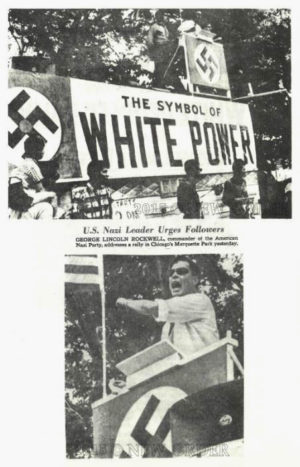
Understandably, the politicians and the police were unhappy about these developments. The news media was beside itself in anguish. One Chicago television station chose this moment to broadcast a documentary about the so-called “holocaust” and other alleged atrocities committed by the Germans during World War II. It had no effect on the residents of the White neighborhoods: the spell of media hypnosis had been broken by the harsh racial realities on the ground.
Democratic Mayor Richard Daley had joined with the media in denouncing the White resistance as being made up of “thugs” and “hooligans.” But the Marquette Park rally had shown that family men with jobs and women with children also backed the White revolt. The uprising was threatening the base upon which Daley’s notoriously corrupt political machine rested.
For his part, Martin Luther King realized that he had bitten off more than he could chew. When he announced a new series of provocative, confrontational marches into nearby all-White Cicero, his White liberal supporters balked and withdrew their financial support. King knew that he had pushed things too far — so far that the local Whites had turned to the “Nazis” for leadership.
On Thursday, August 25 (four days after the Marquette Park rally), King and the Chicago Freedom Movement met with Mayor Daley and other city officials. King agreed to call off any future marches and demonstrations in exchange for some token concessions by the city. King left Chicago, and turned his attentions to protesting the Vietnam War. Daley quickly reneged on his concessions, but King never challenged him on it. He was beaten and he knew it. Some of the local Negro agitators wanted to continue the campaign to forcibly integrate White neighborhoods, but their efforts came to naught.
The White uprising had been victorious, and the endangered neighborhoods would remain White for another dozen years. The combination of White rage and National Socialist leadership had proven to be a winning formula.
But Rockwell was not content to sit back and rest on his success. He had another card to play: he had announced a mass “White People’s March” for September 10, to be followed that evening by a public White Power rally in the Chicago Colosseum. Cook County Sheriff Richard Ogilvie told the press that he would arrest Rockwell if he set foot in the county. “On what charges?” he was asked. “I don’t know — I’ll think of something,” Ogilvie snapped back.
Thus the stage was set for another confrontation.
* * *
Source: New Order




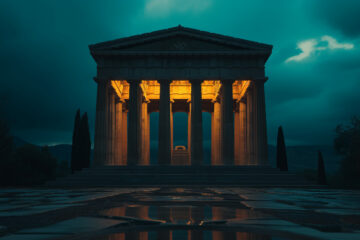
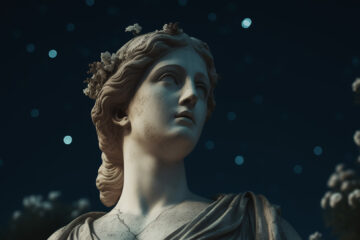
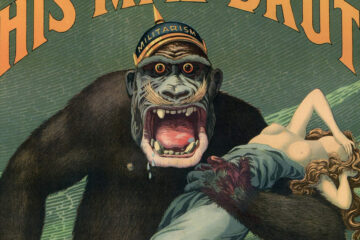
Not everyone has forgotten this episode of American history. It was one of the last significant instances of White resistance to the Jewish agenda and Rockwell deserves full credit for his efforts.
A greatly written article. I hope as many people read this as possible.
Sadly, the commander was murdered the next year. Think of what he could have accomplished if that jew-loving traitor hadn’t stolen him from us!
In the presence of the enemy. I mentioned before that a member of the Ol’ White Peoples Party told me why Mr. Rockwell chose to place his operation on the Potomac. The Commander understood if they were attacked or fire-bombed, it would make world news.
Excellent article, Mr. Kerr! I had been fascinated by Rockwell’s interview in the April 1966 Playboy magazine just prior to going in the Army a few weeks later, right after graduation from high school. Reread it several times and recall having never seen such honest discussion about race before that. https://christosculture.com/2019/02/06/george-lincoln-rockwell-playboy-interview/
I’d finished Basic Training at Fort Jackson, SC, and was being “held over” there when all of this happened in August, and never heard about it because we didn’t have television or even newspapers on post. A youngster then, I’m one of those “late middle-agers” who wishes now I’d joined with Rockwell to fight in that war — this war — instead of that ill-advised, far-flung military adventure on the other side of the world.
Some souvenirs of the fights in Chicago. I got the ‘White Power’ shirt and the ‘Niggers Beware’ shirt from ANP members in Marquette Park during the so-called ‘open housing’ marches. I was privileged to play some little part there. VERY little part, but we do what we can, and a 12 year-old can only do so much!
The second shirt given me by the ANP in Marquette Park. There were bumper-stickers of this all over the neighborhoods affected, MP, Gage Park, Bridgeport, Canaryville…
Two more shirts from Chicago back in the day, the ‘Run Jesse Run’ shirt is from 1984, when Jesse first ran for president. The ‘Boys in the Hood’ shirt is from 1989, and was always popular when I was out and about.
The Jesse shirt, this is from 1984, when he first ran for president, the local Klavern was swelling them at a motorsickle swap-meet outside of Belvidere, Illinois.